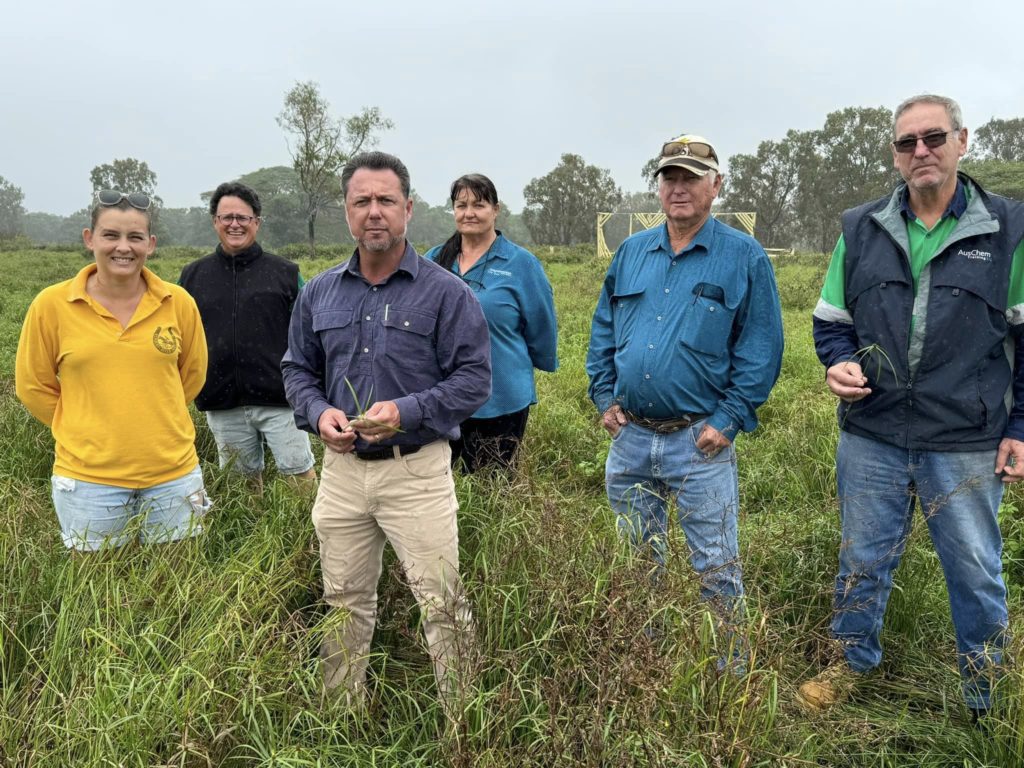Navua sedge – Industry Update

L to R: Adrienne Kelley (Herbert River Pony Club), Lawrence Di Bella (QCAR Senior Technical Officer, Nick Dametto MP, Cr Kate Milton, Robert Lyon (local grower) and Richard Hobbs (HCPSL).
11 July 2024
Earlier this month, Hinchinbrook MP and Katter’s Australian Party (KAP) Deputy Leader Nick Dametto met with community members and agricultural industry stakeholders in relation to the unrelenting spread of Navua sedge (Cyperus aromaticus) across the Herbert district.
Recent updates provided on behalf of the Department of Agriculture and Fisheries (DAF) indicated that a rust pathogen had been detected in the Atherton Tablelands that was killing the invasive weed.
Mr Dametto said that whilst that was promising news, questions needed to be asked about why further research into the rust fungus would not continue as this appeared to be the most effective and likely solution to curbing the spread.
“I wrote to the Minister for Agriculture and Industry Development and Fisheries seeking clarification around what research will be continuing,” he said.
“The response I received was positive and confirmed that the leaf rust, spread by the wind, has now widely spread across the Atherton Tablelands and neighbouring coastal lowland regions from Innisfail to Cape Tribulation.
“Significant above-ground tiller mortality in Navua sedge has been observed. However, infected plants continue to resprout from underground rhizomes. It is hoped that re-infection by rust over many years may reduce the underground rhizome biomass, resulting in long-term management. At this stage, this approach appears to be the most suitable and cost-effective outcome.
“Given that the rust is quite widespread, the Minister’s office confirmed that there is no need to continue overseas research that would be required to enable regulatory approvals for its introduction to Australia. However, domestic research by DAF will continue to include host specificity tests, and to monitor the distribution and impact of the rust in the field.
“Initial research has shown that the leaf rust has not been found on native pastures and sedges, indicating that it is likely to be host specific. Once this is confirmed, then a recommendation to redistribute the rust can be made.
“Additionally, overseas in the United Kingdom research has been prioritised into a flower infecting smut fungus. Once the host testing of the smut fungus is complete, and if deemed appropriate, an application seeking approval for its release into Australia can be made.
“In the long term, it is envisioned that the flower-infecting smut will complement the leaf and stem-infecting rust and act as multi-biological control agents for Navua sedge.
“Whist this update should provide much needed confidence that a solution might be on the horizon, it must be remembered that the above biological controls are subject to testing outcomes and in the event they are fully implemented, the estimated timeframe for that is mid-2025. In the meantime, strategies around exclusion zones for mowing and slashing should be practiced diligently to reduce the spread.”
-END-





